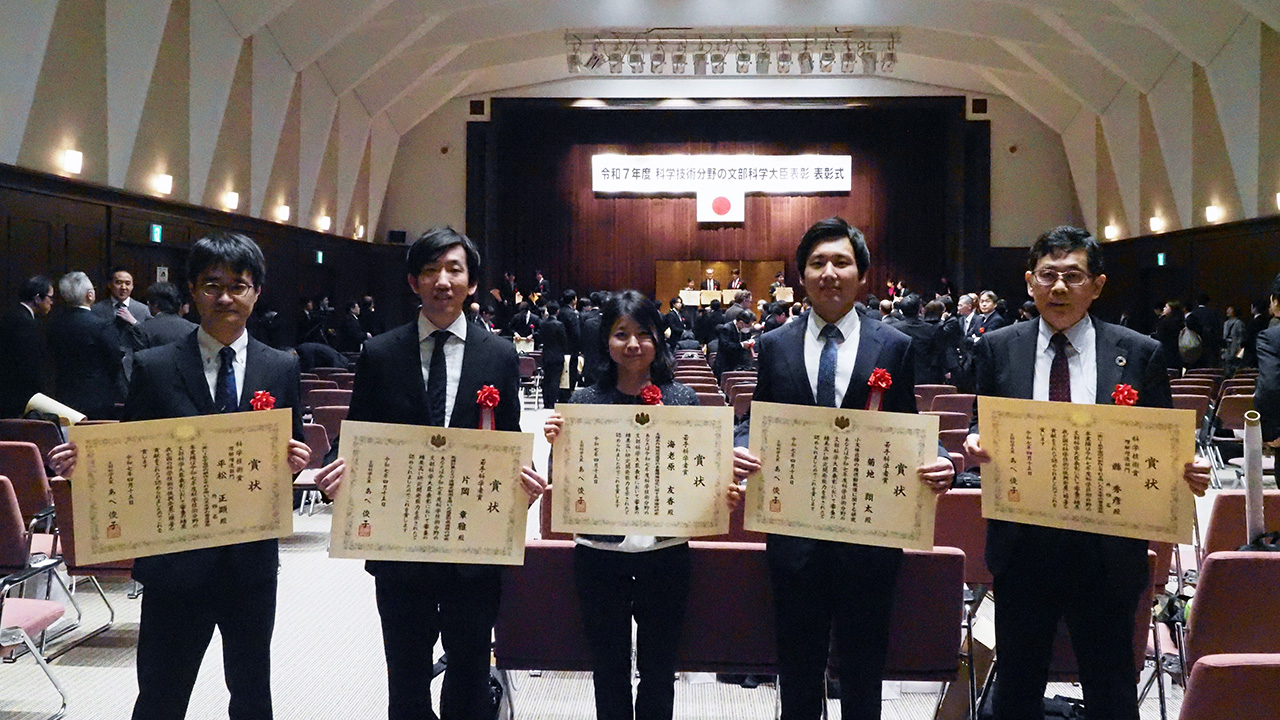NAOJ Researchers Receive the 2025 Commendation for Science and Technology by the Minister of Education, Culture, Sports, Science and Technology
| Topics

The award winners of the 2025 Commendation for Science and Technology by the Minister of Education, Culture, Sports, Science and Technology (MEXT) have been announced, and an awards ceremony was held on April 15, 2025. From NAOJ, Assistant Professor Akimasa Kataoka and Associate Professor Yuka Fujii of the Division of Science and Assistant Professor Shota Kikuchi of the RISE Project received the Young Scientists’ Award; while Associate Professor Hidehiko Agata and Associate Professor (Senior Lecturer) Masaaki Hiramatsu of the Public Relations Center received the Award for Science and Technology (Public Understanding Promotion Category) as the main members of the Diagram of Our Universe production.
Kataoka received the award for his work on “Research on planet formation processes using numerical calculations and millimeter-wave polarization observations.”
Planets are believed to form from tiny dust grains colliding with each other in a gaseous disk surrounding a young star (known as protoplanetary disk). However, previous theoretical models have struggled to explain planet formation, as they predicted that the dust agglomerates would break apart upon colliding. Using numerical calculations, Kataoka has theoretically shown that dust grains can successfully stick together because they form porous, non-spherical structures rather than solid spheres. He further tested this theory through observational research using ALMA’s millimeter-wave polarization measurements of protoplanetary disks.
Fujii was awarded for her work on “Theoretical studies to constrain the surface environment of extrasolar terrestrial planets.”
Many exoplanets (planets outside our Solar System) have now been discovered, and some of them may have temperatures that can support surface liquid water, which is considered necessary for life. However, it is not possible to directly see exoplanet surfaces in detail, and we can only infer their properties from highly limited observational data. Based on data from Earth observation satellites and atmospheric simulations, Fujii has calculated how Earth-like planets would be observed from an astronomical distance and revealed the observable features in the point-source signals of exoplanets that can be used to infer the properties of the planetary surface environment, such as the presence of oceans and continents.
Kikuchi received the award for his work on, “Strongly perturbed orbits in the vicinity of small bodies.”
Around comets and asteroids, the weak gravity leads to complex motion of objects such as spacecraft and dust grains. Understanding the dynamics around small bodies is critical for the practical realization of their exploration and the scientific investigation of their formation processes. Kikuchi developed fundamental dynamical theories for orbital motion strongly disturbed by the non-uniform gravity of irregularly shaped small bodies and solar radiation pressure. These theoretical studies extended the framework developed by Yoshihide Kozai (deceased), the first Director General of NAOJ. Furthermore, using numerical methods, Kikuchi estimated the gravity of the asteroid Ryugu, the target of the Hayabusa2 spacecraft, from the orbital motion of artificial objects.
Agata and Hiramatsu, together with the other three main members of The Diagram of Our Universe production received the reward in recognition of their work in “producing a ‘One for Every Household’ Diagram of Our Universe and using it for astronomy promotion and public education.”
In 2007, the team produced a ‘One for Every Household’ Diagram of Our Universe, which provides an overview of the entire Universe by mapping various studies in the field of astronomy on a space-time diagram, as part of the MEXT’s ‘One for Every Household’ series and the diagrams were distributed free of charge to elementary, junior high, and high schools and social education facilities across the country. Since then, three revised editions have been produced, and each revision has been distributed free of charge to schools nationwide. In addition, science communication activities such as lectures, science cafés, and workshops have been held using this diagram, and proposals for its effective use have been made to the astronomy community in Japan and abroad through conferences and other events. Through these activities, this diagram has been recognized as a symbol of astronomy and has also appeared as a prop in anime and TV dramas.